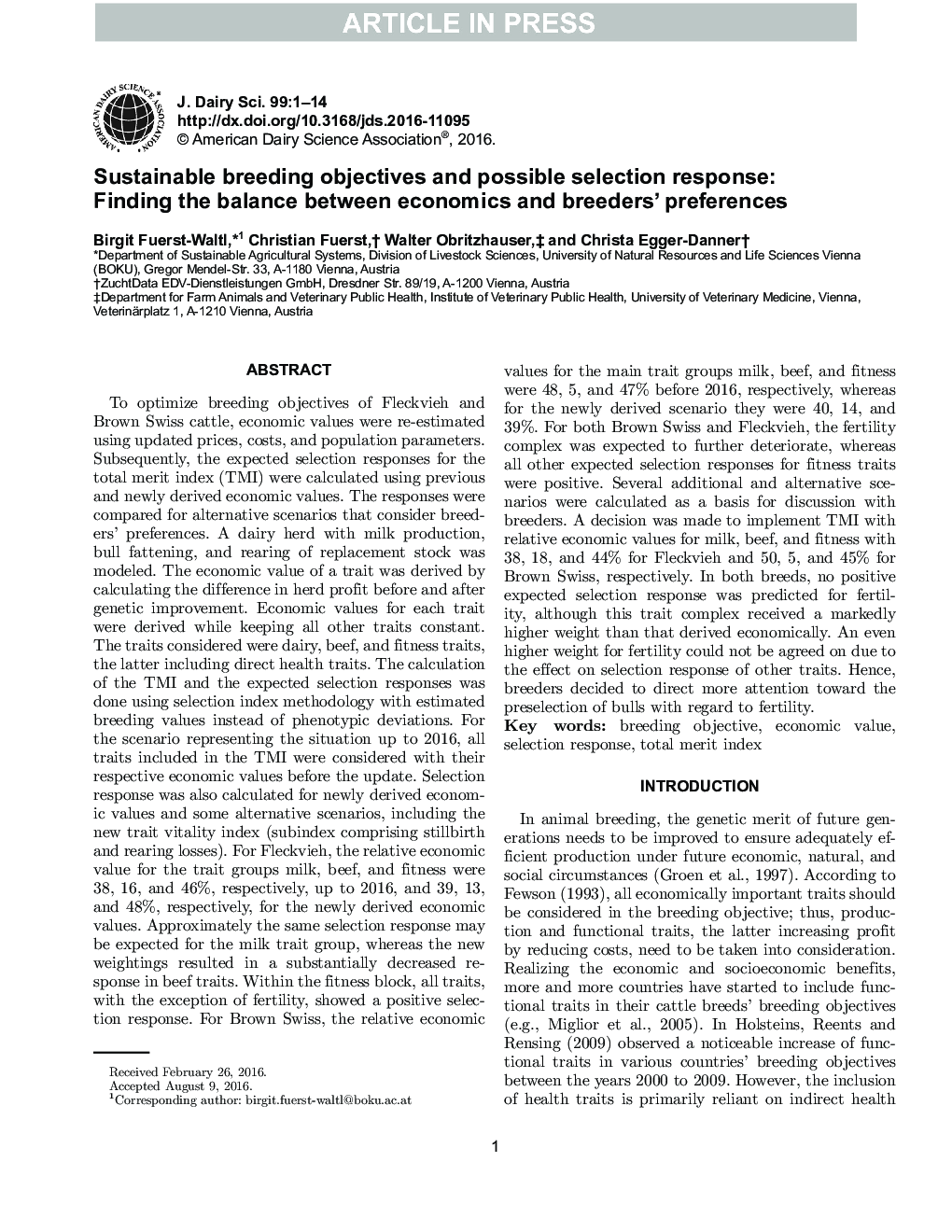| کد مقاله | کد نشریه | سال انتشار | مقاله انگلیسی | نسخه تمام متن |
|---|---|---|---|---|
| 5542751 | 1402522 | 2016 | 14 صفحه PDF | دانلود رایگان |
عنوان انگلیسی مقاله ISI
Sustainable breeding objectives and possible selection response: Finding the balance between economics and breeders' preferences
ترجمه فارسی عنوان
اهداف پرورش پایدار و واکنش انتخاب ممکن: پیدا کردن تعادل بین اقتصاد و ترجیحات پرورشدهندگان
دانلود مقاله + سفارش ترجمه
دانلود مقاله ISI انگلیسی
رایگان برای ایرانیان
کلمات کلیدی
هدف پرورش، ارزش اقتصادی، پاسخ انتخاب شاخص شایستگی کل،
موضوعات مرتبط
علوم زیستی و بیوفناوری
علوم کشاورزی و بیولوژیک
علوم دامی و جانورشناسی
چکیده انگلیسی
To optimize breeding objectives of Fleckvieh and Brown Swiss cattle, economic values were re-estimated using updated prices, costs, and population parameters. Subsequently, the expected selection responses for the total merit index (TMI) were calculated using previous and newly derived economic values. The responses were compared for alternative scenarios that consider breeders' preferences. A dairy herd with milk production, bull fattening, and rearing of replacement stock was modeled. The economic value of a trait was derived by calculating the difference in herd profit before and after genetic improvement. Economic values for each trait were derived while keeping all other traits constant. The traits considered were dairy, beef, and fitness traits, the latter including direct health traits. The calculation of the TMI and the expected selection responses was done using selection index methodology with estimated breeding values instead of phenotypic deviations. For the scenario representing the situation up to 2016, all traits included in the TMI were considered with their respective economic values before the update. Selection response was also calculated for newly derived economic values and some alternative scenarios, including the new trait vitality index (subindex comprising stillbirth and rearing losses). For Fleckvieh, the relative economic value for the trait groups milk, beef, and fitness were 38, 16, and 46%, respectively, up to 2016, and 39, 13, and 48%, respectively, for the newly derived economic values. Approximately the same selection response may be expected for the milk trait group, whereas the new weightings resulted in a substantially decreased response in beef traits. Within the fitness block, all traits, with the exception of fertility, showed a positive selection response. For Brown Swiss, the relative economic values for the main trait groups milk, beef, and fitness were 48, 5, and 47% before 2016, respectively, whereas for the newly derived scenario they were 40, 14, and 39%. For both Brown Swiss and Fleckvieh, the fertility complex was expected to further deteriorate, whereas all other expected selection responses for fitness traits were positive. Several additional and alternative scenarios were calculated as a basis for discussion with breeders. A decision was made to implement TMI with relative economic values for milk, beef, and fitness with 38, 18, and 44% for Fleckvieh and 50, 5, and 45% for Brown Swiss, respectively. In both breeds, no positive expected selection response was predicted for fertility, although this trait complex received a markedly higher weight than that derived economically. An even higher weight for fertility could not be agreed on due to the effect on selection response of other traits. Hence, breeders decided to direct more attention toward the preselection of bulls with regard to fertility.
ناشر
Database: Elsevier - ScienceDirect (ساینس دایرکت)
Journal: Journal of Dairy Science - Volume 99, Issue 12, December 2016, Pages 9796-9809
Journal: Journal of Dairy Science - Volume 99, Issue 12, December 2016, Pages 9796-9809
نویسندگان
Birgit Fuerst-Waltl, Christian Fuerst, Walter Obritzhauser, Christa Egger-Danner,
